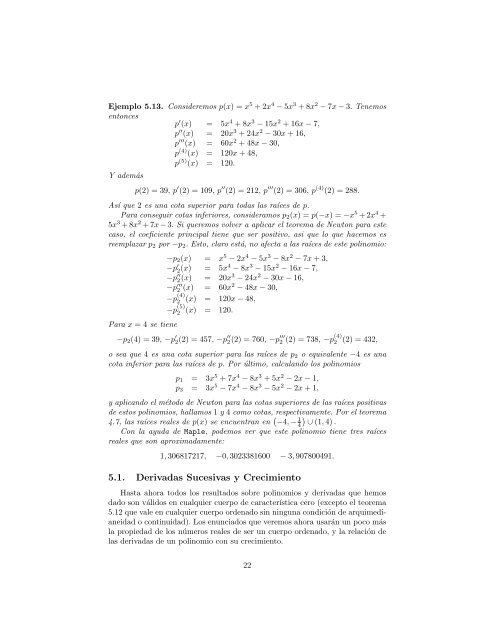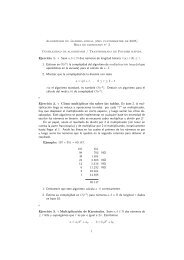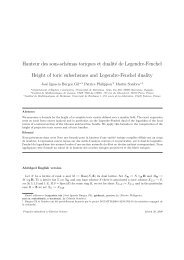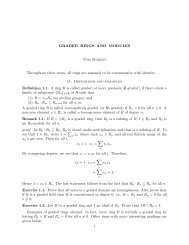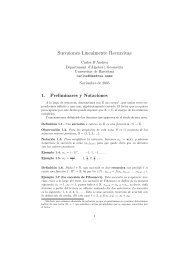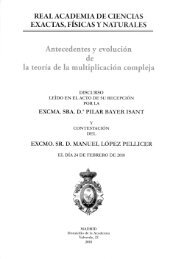Notes - Departament d'Àlgebra i Geometria - Universitat de Barcelona
Notes - Departament d'Àlgebra i Geometria - Universitat de Barcelona
Notes - Departament d'Àlgebra i Geometria - Universitat de Barcelona
You also want an ePaper? Increase the reach of your titles
YUMPU automatically turns print PDFs into web optimized ePapers that Google loves.
Ejemplo 5.13. Consi<strong>de</strong>remos p(x) = x 5 + 2x 4 − 5x 3 + 8x 2 − 7x − 3. Tenemos<br />
entonces<br />
p ′ (x) = 5x 4 + 8x 3 − 15x 2 + 16x − 7,<br />
p ′′ (x) = 20x 3 + 24x 2 − 30x + 16,<br />
p ′′′ (x) = 60x 2 + 48x − 30,<br />
p (4) (x) = 120x + 48,<br />
p (5) (x) = 120.<br />
Y a<strong>de</strong>más<br />
p(2) = 39, p ′ (2) = 109, p ′′ (2) = 212, p ′′′ (2) = 306, p (4) (2) = 288.<br />
Así que 2 es una cota superior para todas las raíces <strong>de</strong> p.<br />
Para conseguir cotas inferiores, consi<strong>de</strong>ramos p2(x) = p(−x) = −x 5 + 2x 4 +<br />
5x 3 + 8x 2 + 7x − 3. Si queremos volver a aplicar el teorema <strong>de</strong> Newton para este<br />
caso, el coeficiente principal tiene que ser positivo, asi que lo que hacemos es<br />
reemplazar p2 por −p2. Esto, claro está, no afecta a las raíces <strong>de</strong> este polinomio:<br />
−p2(x) = x 5 − 2x 4 − 5x 3 − 8x 2 − 7x + 3,<br />
−p ′ 2(x) = 5x 4 − 8x 3 − 15x 2 − 16x − 7,<br />
−p ′′<br />
2(x) = 20x3 − 24x2 −p<br />
− 30x − 16,<br />
′′′<br />
2 (x) = 60x2 −p<br />
− 48x − 30,<br />
(4)<br />
2 (x) = 120x − 48,<br />
(x) = 120.<br />
−p (5)<br />
2<br />
Para x = 4 se tiene<br />
−p2(4) = 39, −p ′ 2(2) = 457, −p ′′<br />
2(2) = 760, −p ′′′<br />
2 (2) = 738, −p (4)<br />
(2) = 432,<br />
o sea que 4 es una cota superior para las raíces <strong>de</strong> p2 o equivalente −4 es una<br />
cota inferior para las raíces <strong>de</strong> p. Por último, calculando los polinomios<br />
p1 = 3x 5 + 7x 4 − 8x 3 + 5x 2 − 2x − 1,<br />
p3 = 3x 5 − 7x 4 − 8x 3 − 5x 2 − 2x + 1,<br />
y aplicando el método <strong>de</strong> Newton para las cotas superiores <strong>de</strong> las raíces positivas<br />
<strong>de</strong> estos polinomios, hallamos 1 y 4 como cotas, respectivamente. Por el teorema<br />
4.7, las raíces reales <strong>de</strong> p(x) se encuentran en −4, − 1<br />
<br />
4 ∪ (1, 4) .<br />
Con la ayuda <strong>de</strong> Maple, po<strong>de</strong>mos ver que este polinomio tiene tres raíces<br />
reales que son aproximadamente:<br />
1, 306817217, −0, 3023381600 − 3, 907800491.<br />
5.1. Derivadas Sucesivas y Crecimiento<br />
Hasta ahora todos los resultados sobre polinomios y <strong>de</strong>rivadas que hemos<br />
dado son válidos en cualquier cuerpo <strong>de</strong> característica cero (excepto el teorema<br />
5.12 que vale en cualquier cuerpo or<strong>de</strong>nado sin ninguna condición <strong>de</strong> arquimedianeidad<br />
o continuidad). Los enunciados que veremos ahora usarán un poco más<br />
la propiedad <strong>de</strong> los números reales <strong>de</strong> ser un cuerpo or<strong>de</strong>nado, y la relación <strong>de</strong><br />
las <strong>de</strong>rivadas <strong>de</strong> un polinomio con su crecimiento.<br />
22<br />
2


